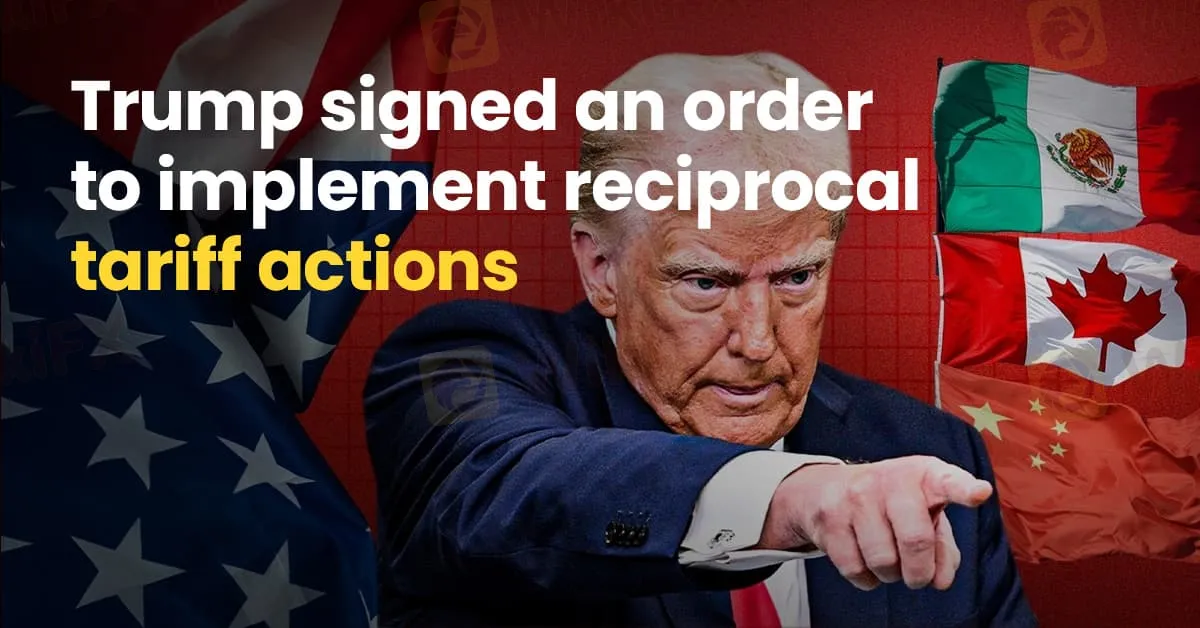简体中文
繁體中文
English
Pусский
日本語
ภาษาไทย
Tiếng Việt
Bahasa Indonesia
Español
हिन्दी
Filippiiniläinen
Français
Deutsch
Português
Türkçe
한국어
العربية
Trump signed an order to implement reciprocal tariff actions
Abstract:The directive includes calculating duties to match those other countries charge and addressing non-tariff barriers such as vehicle safety rules and value-added taxes that hinder U.S. exports.

On February 13, 2025, President Donald Trump signed a memorandum directing his economic team to develop plans for implementing reciprocal tariffs on all countries that impose tariffs on U.S. imports. This strategy aims to ensure fairness by matching the tariffs charged by other nations on American goods. The directive includes calculating duties to match those other countries charge and addressing non-tariff barriers such as vehicle safety rules and value-added taxes that hinder U.S. exports.
According to Reuters, the Key Aspects of the Reciprocal Tariff Plan include:
- Targeted Countries: The plan focuses on major trading partners, including China, Japan, South Korea, and the European Union.
- Implementation Timeline: While the memorandum initiates the development process, the new tariffs are not expected to be levied immediately. White House officials have indicated that the administration aims to move quickly, suggesting a timeline of “weeks” rather than “months” for implementation.
- Economic Implications: The announcement has raised concerns about potential economic repercussions, including fears of a global trade war and the possibility of increased consumer prices. However, Wall Street responded positively, relieved that new tariffs were not immediately implemented.
Context and Background
This move is part of President Trump's broader efforts to address trade imbalances and promote fair trade practices. The reciprocal tariff plan builds upon previous actions, such as the 25% tariffs on steel and aluminum imports and the 10% tariffs on Chinese goods. The administration's approach reflects a shift towards more protectionist trade policies, aiming to level the playing field for U.S. industries.
Potential Global Impact
The implementation of reciprocal tariffs could lead to significant changes in global trade dynamics. Countries affected by these tariffs may seek to negotiate trade agreements to reduce or eliminate the new duties. Additionally, businesses may need to adjust their supply chains and pricing strategies in response to the changing trade environment.
As the Trump administration moves forward with this plan, the global community will be closely monitoring the developments and their potential impact on international trade relations.

Disclaimer:
The views in this article only represent the author's personal views, and do not constitute investment advice on this platform. This platform does not guarantee the accuracy, completeness and timeliness of the information in the article, and will not be liable for any loss caused by the use of or reliance on the information in the article.
Read more

Gold Prices Pull Back, Near Four-Week Low Amid Easing Risk Sentiment
As risk aversion fades and investors turn their attention to U.S. inflation data, gold prices retreat sharply, falling to their lowest levels in nearly a month.

Using Any of These Illegal Forex Trading Apps? Stop Before It Turns into a Crisis
The Reserve Bank of India (RBI) has listed out some illegal forex apps India. Read this article to know some of those apps.

IC Markets Sponsors AEL Limassol, Football Club Until 2027
AEL Limassol has renewed its deal with IC Markets (EU) Ltd, who will stay as the team’s Gold Sponsor until 2027. The sponsorship deal was first announced for the 2025–2026 season, but it has now been officially extended until 2027.

5 Reasons to Stay Away from Core Prime Markets
The Forex market is a very unpredictable, complex, and risky place. There are many brokers that appear genuine but can steal your hard-earned money. So, staying alert is the only way to survive in this dynamic environment. Therefore, in this article, we are sharing 5 warning signs about Core Prime Markets.
WikiFX Broker
Latest News
Asian chip stocks rise after Nvidia reclaims title of the world's most valuable company
Nvidia's comeback sparks a rally in Asian chip stocks
CNBC Daily Open: Despite all the uncertainty, the S&P 500 is flirting with record highs — strange times
PU Prime and AFA Announce Partnership at Madrid Event
eToro UK Launches 4% Stock Cashback Card: Earn Up to £1,500 Monthly
EBC Expands ETF CFD Offering & Copy Trading Education Partnership
Gold Prices Continue to Fall as Israel, Iran Agree on Ceasefire
China steps up push to internationalise the yuan as global dollar dominance wavers
Multibank Group Offices: Global Presence and Contact Info
ESMA Proposes Reporting Reforms That Could Cut Costs for Forex Brokers
Currency Calculator


